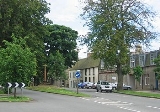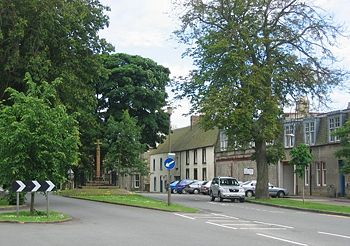
Ormiston
Encyclopedia

East Lothian
East Lothian is one of the 32 council areas of Scotland, and a lieutenancy Area. It borders the City of Edinburgh, Scottish Borders and Midlothian. Its administrative centre is Haddington, although its largest town is Musselburgh....
, Scotland
Scotland
Scotland is a country that is part of the United Kingdom. Occupying the northern third of the island of Great Britain, it shares a border with England to the south and is bounded by the North Sea to the east, the Atlantic Ocean to the north and west, and the North Channel and Irish Sea to the...
, UK, near Tranent
Tranent
Tranent is a town in East Lothian, Scotland. It is close to the A1 road and approximately east of Edinburgh. It is one of the oldest towns in East Lothian, and built on a gentle slope, about 300 feet above sea level.Population of the town is 9,917....
, Humbie
Humbie
Humbie is a hamlet and rural parish in East Lothian, Scotland. It lies in the south-west of the county, approximately 10 miles south-west of Haddington and 15 miles south-east of Edinburgh. Humbie as we know it today was formed as the result of the union between Keith Marischal and Keith Hundeby in...
, Pencaitland
Pencaitland
Pencaitland is a village in East Lothian, Scotland, about south-east of Edinburgh, south-west of Haddington, and east of Ormiston.The land where the village lies is said to have been granted by William the Lion to Calum Cormack in 1169, who gave the church, with the tithes and other property...
and Cranston
Cranston
Cranston or Cranstoun is a Scottish surname originating in a clan that lived around Roxburgh in the Scottish Borders. It is a minor clan but has its own tartan and clan brooch.-Notable people:...
, located on the north bank of the River Tyne
River Tyne, Scotland
The River Tyne is a river in Scotland, UK. It rises in the Moorfoot Hills in Midlothian near Tynehead to the south of Edinburgh, at the junction of the B6458 and the B6367. It continues for approx...
at an elevation of about 276 ft.
The village was the first planned village in Scotland, founded in 1735 by John Cockburn
John Cockburn (Scottish politician)
John Cockburn of Ormiston, East Lothian, was a Scottish politician, the son of Adam Cockburn of Ormiston, Lord Justice Clerk. He is also known as the father of Scottish husbandry....
(1685–1758), one of the initiators of the Agricultural Revolution
Agricultural revolution
Agricultural Revolution or Agrarian Revolution may refer to:*The Neolithic Revolution , the initial transition from hunting and gathering to settled agriculture in prehistory...
.
Name
The word Ormiston is derived from a half mythical AnglianAnglo-Saxons
Anglo-Saxon is a term used by historians to designate the Germanic tribes who invaded and settled the south and east of Great Britain beginning in the early 5th century AD, and the period from their creation of the English nation to the Norman conquest. The Anglo-Saxon Era denotes the period of...
settler called Ormr, meaning 'serpent' or 'snake'. 'Ormres' family had possession of the land during the 12th and 13th centuries. Ormiston or 'Ormistoun' is not an uncommon surname, and Ormr also survives in some English placenames such as Ormskirk
Ormskirk
Ormskirk is a market town in West Lancashire, England. It is situated north of Liverpool city centre, northwest of St Helens, southeast of Southport and southwest of Preston.-Geography and administration:...
and Ormesby
Ormesby
Ormesby is a former village, and now suburb, spanning the Middlesbrough and Redcar and Cleveland unitary authorities in north east England, within the ceremonial county of North Yorkshire. It forms part of the Middlesbrough urban agglomeration...
.
The latter part of the name, formerly spelt 'toun', is likely to descend from its Northumbrian Old English and later Scots
Scots language
Scots is the Germanic language variety spoken in Lowland Scotland and parts of Ulster . It is sometimes called Lowland Scots to distinguish it from Scottish Gaelic, the Celtic language variety spoken in most of the western Highlands and in the Hebrides.Since there are no universally accepted...
meaning as 'farmstead' or 'farm and outbuildings' rather than the meaning 'town'.
Design
The village consists mainly of a broad Main Street, with a row of two storey houses along each side. It crosses two bridges, one over the now redundant railway route, and the other a narrow bridge over the river. Using strict guidelines for its appearance, John Cockburn put housing for artisanArtisan
An artisan is a skilled manual worker who makes items that may be functional or strictly decorative, including furniture, clothing, jewellery, household items, and tools...
s and cottage industries (spinning
Spinning (textiles)
Spinning is a major industry. It is part of the textile manufacturing process where three types of fibre are converted into yarn, then fabric, then textiles. The textiles are then fabricated into clothes or other artifacts. There are three industrial processes available to spin yarn, and a...
and weaving
Weaving
Weaving is a method of fabric production in which two distinct sets of yarns or threads are interlaced at right angles to form a fabric or cloth. The other methods are knitting, lace making and felting. The longitudinal threads are called the warp and the lateral threads are the weft or filling...
) around the original mill hamlet
Hamlet
The Tragical History of Hamlet, Prince of Denmark, or more simply Hamlet, is a tragedy by William Shakespeare, believed to have been written between 1599 and 1601...
. When he did not achieve the expected return on his investment, he sold it to the Earl of Hopetoun in 1747. The linen
Linen
Linen is a textile made from the fibers of the flax plant, Linum usitatissimum. Linen is labor-intensive to manufacture, but when it is made into garments, it is valued for its exceptional coolness and freshness in hot weather....
trade became a failure, and by 1811 the distillery shut down. A brewery and one of Scotland's first bleachfields were also built here as well. Ormiston later became a mining
Mining
Mining is the extraction of valuable minerals or other geological materials from the earth, from an ore body, vein or seam. The term also includes the removal of soil. Materials recovered by mining include base metals, precious metals, iron, uranium, coal, diamonds, limestone, oil shale, rock...
village (Ormiston Coal Company).
Ormiston Coal Co. Ltd.
The principal collieries at Ormiston were:- Limeylands (NT406695, 1 km west of the Mercat Cross), opened 1895, closed 1954, though the Coal Preparation Plant stayed in use until about October 1958.
- Tynemount (NT401686, 1.5 km west-south-west of the Mercat Cross), opened 1924, closed January 1952, but not formally abandoned until 1962.
- Oxenford No. 2 (NT393678, south-west of Tynemount), opened 1926, closed 1950.
- Oxenford No. 3 (NT393677), a new pit very close by, was opened by the National Coal BoardNational Coal BoardThe National Coal Board was the statutory corporation created to run the nationalised coal mining industry in the United Kingdom. Set up under the Coal Industry Nationalisation Act 1946, it took over the mines on "vesting day", 1 January 1947...
, but closed in 1952. - Winton Mine (NT421699), first provided for ventilation purposes in 1943, but developed as a mine by the National Coal Board in 1952, closed in 1962.
- Source 1: Industrial Locomotives of Scotland, Alan Bridges (ed.), Industrial Railway Society, Market Harborough, 1976, ISBN 0901096245
- Source 2: Scottish Collieries: An Inventory of the Scottish Coal Industry in the Nationalised Era, by Miles K. Oglethorpe, RCAHMS, Edinburgh, 2006, ISBN 9781902419473.
Ormiston Hall
Ormiston Hall was built for Cockburn (1745–48) and was later extended for the Earl of Hopetoun. The remains of the pre-Reformation St Giles Parish Church can still be seen.The Great Yew of Ormiston can be found close to the ruins of Ormiston Hall. The huge central trunk measures 6.9 metres (22 feet 10 inches) in girth.
Shops in Ormiston
There are Shops in Ormiston:- The Co-op Store (The Co-operative)
- Post Office
- The little Superstore
- The Dragon Way (Chinese)
- Post Office
- Lorraine's Shop
Mercat Cross
The 15th-century pre-Reformation Mercat CrossMercat cross
A mercat cross is a market cross found in Scottish cities and towns where trade and commerce was a part of economic life. It was originally a place where merchants would gather, and later became the focal point of many town events such as executions, announcements and proclamations...
on Main Street is unusual for its truly cruciform
Cruciform
Cruciform means having the shape of a cross or Christian cross.- Cruciform architectural plan :This is a common description of Christian churches. In Early Christian, Byzantine and other Eastern Orthodox forms of church architecture this is more likely to mean a tetraconch plan, a Greek cross,...
shape, with three modern steps and a railed enclosure.
Notable people with Ormiston connections
- Birthplace of the ScottishScotlandScotland is a country that is part of the United Kingdom. Occupying the northern third of the island of Great Britain, it shares a border with England to the south and is bounded by the North Sea to the east, the Atlantic Ocean to the north and west, and the North Channel and Irish Sea to the...
Congregationalist missionaryMissionaryA missionary is a member of a religious group sent into an area to do evangelism or ministries of service, such as education, literacy, social justice, health care and economic development. The word "mission" originates from 1598 when the Jesuits sent members abroad, derived from the Latin...
Robert MoffatRobert MoffatRobert Moffat was a Scottish Congregationalist missionary to Africa, and father in law of David Livingstone....
(December 21, 1795 - August 9, 1883); a memorial is erected in his name. He was the father-in-law of David LivingstoneDavid LivingstoneDavid Livingstone was a Scottish Congregationalist pioneer medical missionary with the London Missionary Society and an explorer in Africa. His meeting with H. M. Stanley gave rise to the popular quotation, "Dr...
, the medical missionary and explorer.
- The religious reformer and Protestant martyrMartyrA martyr is somebody who suffers persecution and death for refusing to renounce, or accept, a belief or cause, usually religious.-Meaning:...
George WishartGeorge WishartGeorge Wishart was a Scottish religious reformer and Protestant martyr.He belonged to a younger branch of the Wisharts of Pitarrow near Montrose. He may have graduated M.A., probably at King's College, Aberdeen, and was certainly a student at the University of Leuven, from which he graduated in 1531...
was captured in December 1545 by the Earl of BothwellEarl of BothwellThe title Earl of Bothwell has been created twice in the Peerage of Scotland. It was first created for Patrick Hepburn in 1488, and was forfeited in 1567. It was then created for Francis Stewart in 1587...
while hiding at Ormiston Hall.
Gazetteers
History
Community
- East Lothian council: Ormiston Community Profile
- Ormiston village website
- Ormiston Primary School website
- Ormiston Library (East Lothian Council)

